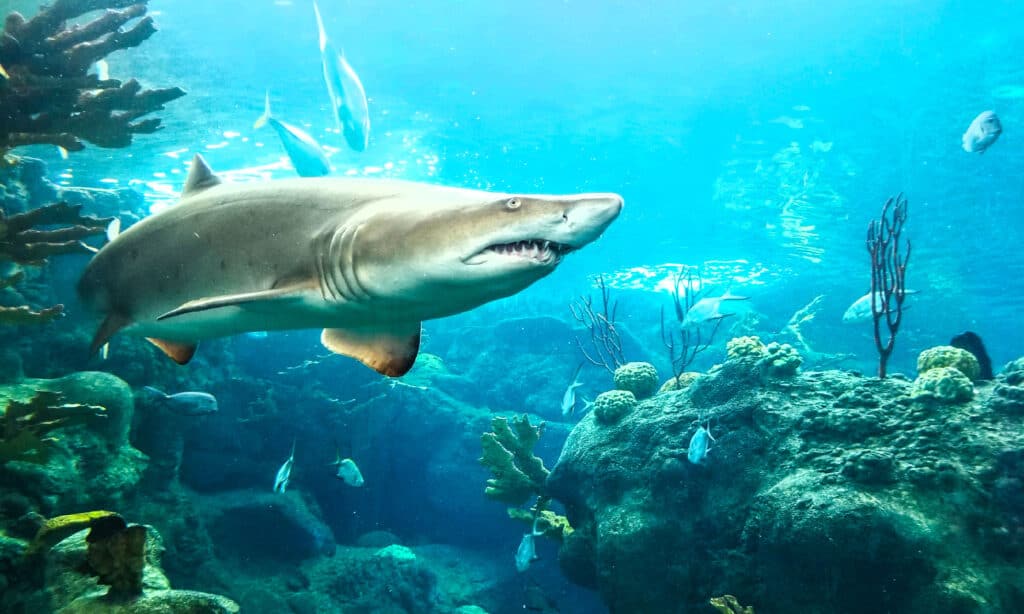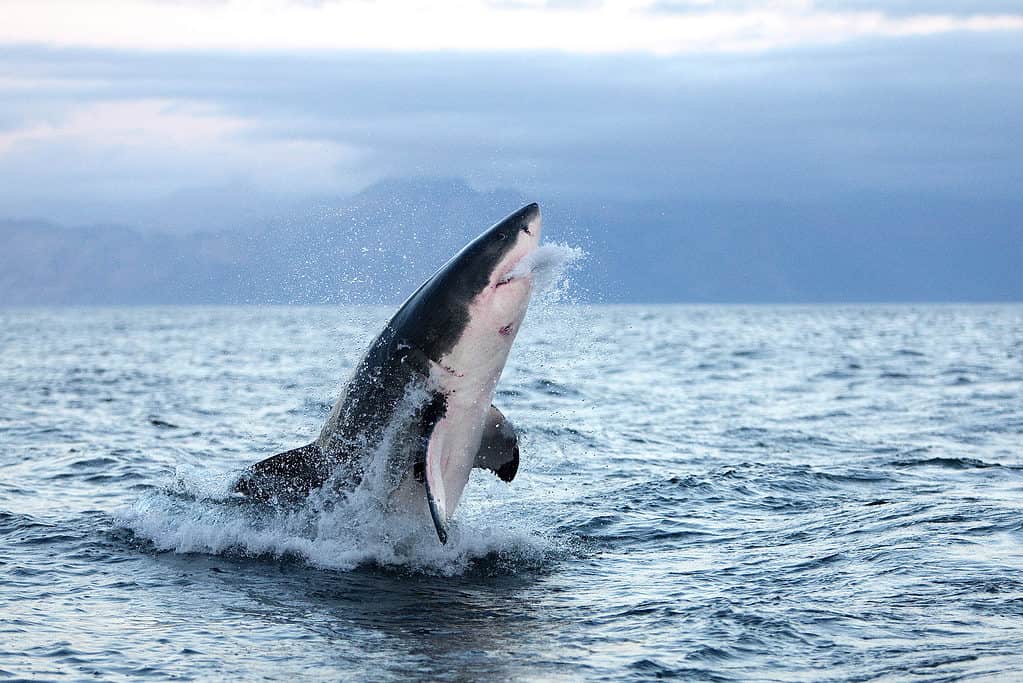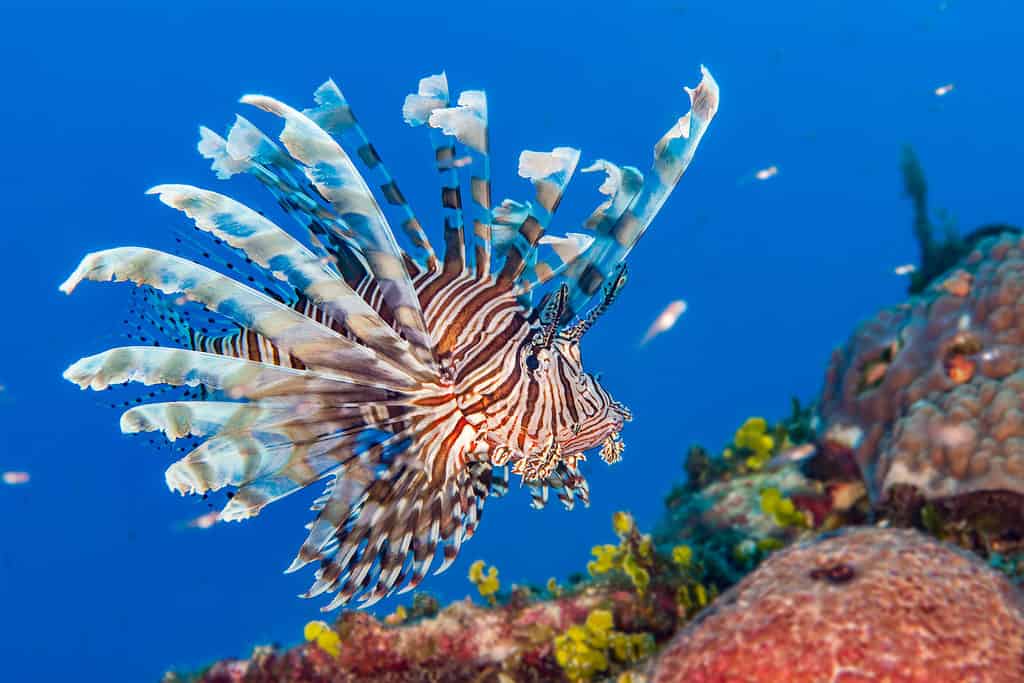The Virginia coast is lined with quiet coastal communities and pristine beaches perfect for family outings. During the summer, the state sees water temperatures between 75 and 82 degrees, perfect for splashing and playing. But swimming in the ocean can be nerve-wracking when you don’t know what could be lurking in the water. Does this northeast state contain deadly sea creatures? The answer is yes. Discover the six most dangerous animals swimming in Virginia’s oceans and how they affect humans.
1. Portuguese Man O’ War

The man o’ war contains deadly venom and up to 30-foot-long tentacles.
©Pedro Sales Prado/Shutterstock.com
The Portuguese man o’ war looks like a jellyfish but is actually a siphonophore, which is related to the jellyfish family. These odd-looking creatures are found in tropical and subtropical areas, carried by wind and ocean currents. And they can travel in groups of more than 1,000! Man o’ wars feature long tentacles that can grow up to 30 feet and extend to around 100 feet, a fact you may not want to think of while swimming in the ocean. Additionally, they contain stinging nematocysts that contain deadly venom. While the venom is meant to paralyze and kill fish, it sometimes harms people, too. While Portuguese man o’ war stings are rarely deadly, they can cause very painful welts. These marine animals occasionally get carried north by currents and sometimes even wash up on Virginia shores.
2. Bull Shark

Bull sharks can swim up canals into freshwater rivers.
©Harry Collins Photography/Shutterstock.com
The bull shark is a medium-sized shark with a stout body and long fins. These sharks are found in shallow, warm oceans, but are also known for their tendency to swim through canals into inland freshwater rivers. Bull sharks have a bad reputation for being one of the most aggressive species, including one of the top sharks most likely to bite humans. To survive, they also turn cannibalistic, eating younger sharks or other shark species. While bull sharks are not abundant in Virginia oceans, they do occasionally find their way about 10 to 20 miles offshore.
3. Tiger Shark

The
tiger
shark is a voracious hunter.
©iStock.com/Sean Craft
Tiger sharks are ground sharks that live in tropical and subtropical oceans. They can grow up to 25 feet long and weigh more than 2,000 pounds. Along with bull sharks, tiger sharks are one of the most aggressive species in the water. These creatures are voracious hunters with a non-discriminating palate, meaning they are less likely to swim away after attacking a human. And they will eat just about anything. Tiger sharks are not common in Virginia waters, but they occasionally make their way to the area, typically staying at least 10 feet away from the shore.
4. Sea Nettle Jellyfish

Sea nettle are one of the most common jellyfish in Virginia waters.
©Ken Wolter/Shutterstock.com
The sea nettle is a true jellyfish that is abundant in the Chesapeake Bay. Atlantic sea nettles are found all along the East Coast and the Gulf of Mexico, where they inhabit open oceans, bays, and estuaries. This species is one of the most common jellyfish in Virginia, especially during summer in brackish water. Sea nettle produces mild toxins, but their stings are painful and can cause varying reactions. Some people experience a burning itch and rash, while others have accompanied muscle cramps and chest tightness.
5. Great White Shark

Great white sharks
are highly migratory.
©slowmotiongli/Shutterstock.com
The great white shark is one of the most well-known shark species on earth. These large mackerel sharks can reach 20 feet long and weigh over 4,000 pounds. And they are highly migratory, swimming across the Pacific and the Atlantic, from warm tropical waters to cold temperate. Great whites are not as common in Virginia waters as other species, but they are spotted near the state sporadically. They also do not travel to the Chesapeake Bay or its tributaries. These sharks are dangerous ocean predators that are among the top three species most likely to bite humans. However, most people survive great white attacks because these sharks typically back off when they realize they’ve mistaken a human for their preferred meal.
6. Lionfish

Lionfish fin rays are venomous.
©bearacreative/Shutterstock.com
While lionfish are native to the Pacific, these venomous marine fish have invaded the Atlantic through intentional releases. They are an invasive species to the warm waters of this region because they harm native coral reef ecosystems. These exotic-looking fish have venomous spines that can penetrate human skin and cause painful stings. Most people experience pain, swelling, and minor bleeding. However, others can have severe allergic reactions to a lionfish sting.
The Most Dangerous Animals Swimming in Virginia’s Oceans: A Recap of the Top 6
| Rank | Most Dangerous Animals Swimming in Virginia’s Oceans |
|---|---|
| #1 | Portuguese man O’ war |
| #2 | Bull shark |
| #3 | Tiger shark |
| #4 | Sea nettle jellyfish |
| #5 | Great white shark |
| #6 | Lionfish |
The photo featured at the top of this post is © kpkellyfl/Shutterstock.com
Thank you for reading! Have some feedback for us? Contact the AZ Animals editorial team.







